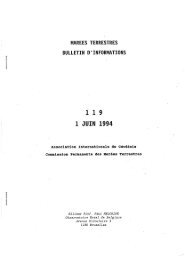marees terrestres bulletin d'informations - Université de la Polynésie ...
marees terrestres bulletin d'informations - Université de la Polynésie ...
marees terrestres bulletin d'informations - Université de la Polynésie ...
You also want an ePaper? Increase the reach of your titles
YUMPU automatically turns print PDFs into web optimized ePapers that Google loves.
from 2D data (pressure and temperature) and a standard atmosphere, we find<br />
that the difference in the attraction effect from the zone up to 0.5° around the<br />
station, the ring-shaped zone of 0.5° - 1.5°, 1.5° - 3°, and 3° - 5° are respectively<br />
4.5 µGal, 3 µGal, 0.8 µGal and 0.26 µGal. In contrast, the differences from the<br />
ring-shaped zone of 5° - 10° and 10° - 15° is below 0.2 µGal. We infer, therefore,<br />
that it makes sense to calcu<strong>la</strong>te atmospheric attraction effect up to 5° using 3D<br />
data<br />
The difference between the physical reductions and the use of an admittance<br />
factor amounts to around 3 µGal with a RMS value of 0.4 µGal in a time span of<br />
4 years and the differences between both physical approaches have a peak-topeak<br />
amplitu<strong>de</strong> of 0.5 µGal including seasonal variations with an amplitu<strong>de</strong> of<br />
0.15 µGal and a RMS value of 0.1 µGal.<br />
From spectral analysis of these three reductions, it emerges that in the spectral<br />
range between 0.0 CPD and 0.18 CPD, the amplitu<strong>de</strong> of the reduction using<br />
(3D+2D) data is 12% smaller than that of the reduction using an admittance<br />
factor on average and 1.3% <strong>la</strong>rger than that of the reduction using 2D data<br />
(pressure and temperature). Moreover, in the spectral range between 0.0 to 2.0<br />
CPD, the difference between the reduction using (3D+2D) data and 2D data<br />
becomes <strong>la</strong>rger (6%). On the other hand, the difference between the reduction<br />
using (3D+2D) and an admittance factor is nearly the same value (12%).<br />
Concerning the tidal analysis, the error bars of the reduction based on an<br />
admittance factor are 44% - 73% for the tidal factors and 42% - 72% for the<br />
phases <strong>la</strong>rger than the reduction using (3D+2D) data by comparing the results.<br />
However, there are no visible improvements between the results based on the<br />
physical approaches.<br />
Comparing the mean amplitu<strong>de</strong> of the gravity residuals for five different period<br />
bands yields also no dramatic differences between the two physical reductions. If<br />
we do not consi<strong>de</strong>r the temperature-<strong>de</strong>pen<strong>de</strong>nt component in the reduction using<br />
2D data, there are 18% differences between both data sets. Moreover, we show<br />
that the amplitu<strong>de</strong> of the residuals after a reduction using an admittance factor<br />
is 1.2 - 3.4 times <strong>la</strong>rger than for the other two methods in the five period bands.<br />
This is exp<strong>la</strong>ined by the fact that the impact of atmosphere cannot be<br />
represented using only one admittance factor for all frequencies due to the<br />
different spatial extensions of air masses and the associated velocities. This<br />
emphasises once more the findings by Warburton and Goodkind (1977), Crossley<br />
et al. (1995) and Neumeyer (1995). The reductions using (3D+2D) data or 2D<br />
data do not have this problem because they can be estimated directly using the<br />
atmospheric cells. The reductions <strong>de</strong>rived from physical approaches capture the<br />
atmospheric effects better than the reduction <strong>de</strong>rived from an admittance factor.<br />
With regard to the <strong>de</strong>velopment of an improved reduction on a physical basis,<br />
the consi<strong>de</strong>ration of 3D data and 2D data with a temperature-<strong>de</strong>pen<strong>de</strong>nt<br />
component leads almost to the same result in the tidal analysis. A 1.5%<br />
difference exists between both physical approaches consi<strong>de</strong>ring temperature<br />
variations in the <strong>de</strong>termination of the amplitu<strong>de</strong> factor of the po<strong>la</strong>r motion<br />
signal.<br />
The effect of actual vertical atmospheric distribution is not obvious; however,<br />
this accuracy is necessary for further studies of small long-period geodynamic<br />
signals such as the po<strong>la</strong>r motion or long-period non-tidal mass shifts in the



